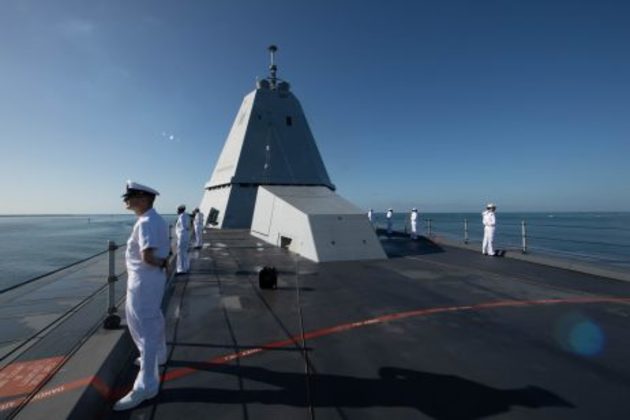In April, the U.S. Navy’s top admiral revealed that it would deploy hypersonic weapons on its advanced Zumwalt-class destroyers by 2025. This is sooner than the previous plans for hypersonic weapon deployment on the Virginia-class attack submarines, set for 2028, and is more enduring than plans to put the weapons on the navy’s aging guided missile submarines in 2025 as an interim capability before they are retired at the end of the decade. As The Diplomat writes, the U.S. Navy’s hypersonic weapon, called the Conventional Prompt Strike (CPS) weapon, is a so-called “boost-glide” weapon. After being lofted – the “boost” – to altitude by a 34.5-inch diameter rocket, its warhead then maneuvers unpowered – the “glide” – to its target at speeds exceeding five times the speed of sound.
However, how the Zumwalts would accommodate hypersonic weapons was unclear until the navy’s 2022 budget was released at the end of May. The vertical launch cells on the U.S. Navy’s Arleigh Burke destroyers and the three huge Zumwalt-class destroyers are 25 inches- and 28 inches-wide respectively, too small for the Conventional Prompt Strike weapon’s 34.5-inch-diameter booster rocket. To put hypersonic weapons on the Zumwalt class, huge new launch tubes need to be installed.
The budget provides new details about those launchers. To fit new launchers, the Zumwalt’s two Advanced Gun System mounts, located on the ship’s forward section, will be removed. An “Advanced Payload Module” will be installed in their place that will carry and launch up to 12 CPS weapons.
The loss of the ships’ Advanced Gun Systems (AGS) – long-range precision naval cannons – is not really a loss. The AGS was originally designed to fire guided 6-inch artillery shells more than 60 nautical miles in support of marines operating ashore. However, when the Zumwalt class was cut from a planned 30 ships to only three, the economics of scale for producing the AGS’s unique ammunition became skewed and the cost-per-round skyrocketed to nearly $1 million, nearly the same as a Tomahawk cruise missile, which has a larger warhead and a range of nearly 1,000 miles. Given the extraordinary cost, the navy decided to cancel any additional ammunition buys for the AGS five years ago, and since the guns cannot fire any of the other precision artillery shells already in production, the guns had become dead weight.
Replacing the Zumwalts’ unusable guns with hypersonic weapons will give the ships a strategic-level capability without sacrificing any of its existing 80 vertical launchers, which are still needed for air-defense and anti-ship missiles. According to the Navy’s budget justification, the hypersonic weapon modification “provides a flexible, surface combatant launched long-range strike capability through the ships’ remaining service life. When combined with the low observable characteristics of the Zumwalt platform, the funds provide a compelling strike capability from a platform designed to complicate an adversaries’ targeting problem.”
The funding documents also reveal that the Zumwalt’s CPS launch system will be the same as found on the Ohio- and Virginia-class submarines. This, combined with the ships’ capacity to carry up to 12 hypersonic weapons, suggests that the Advanced Payload Module the U.S. Navy will install on the Zumwalts is a version of the Virginia Payload Module.
The Virginia Payload Module is a 70-foot-long midsection being added to later Virginia-class attack submarine hulls. The new sections house four large-diameter launch tubes similar to what the navy’s Ohio-class ballistic missile submarines use to launch Trident nuclear missiles. Each tube can carry up to seven Tomahawk cruise missiles or other ordnance. The modified Virginias are meant to replace the conventional missile launch capacity of the navy’s aging guided missile submarines, which were converted from the four oldest Ohio-class submarines to carry 154 Tomahawk cruise missiles instead of nuclear weapons.
The Virginia Payload Tubes that will carry the Navy’s hypersonic weapon in 2028 are 87 inches in diameter, which can accommodate three 34.5-inch-wide booster rockets (with some additional space left for the weapon’s launch cannister). Each Virginia Payload Module has four launch tubes, and each tube appears capable of accommodating three hypersonic weapons, providing for a maximum loadout of 12 hypersonic weapons. Thus the “Advanced Payload Module” that will be installed on the three Zumwalt destroyers in place of their two now-useless cannons is likely a Virginia Payload Module of four large-diameter launch tubes that will be loaded with three CPS weapons each.
Just as the Virginia Payload Tubes can accommodate a number of different weapons, the Zumwalts will also presumably be capable of carrying a mix of hypersonic weapons and large numbers of other new advanced land-attack and anti-ship missiles.
The budget also reveals a goal of producing 24 CPS weapons per year to accommodate both the U.S. Army’s ground-launched hypersonic weapon units (planned to be ready in 2023) and the Zumwalt destroyers ahead of deployment on the Virginia submarines nearer the end of the decade.






